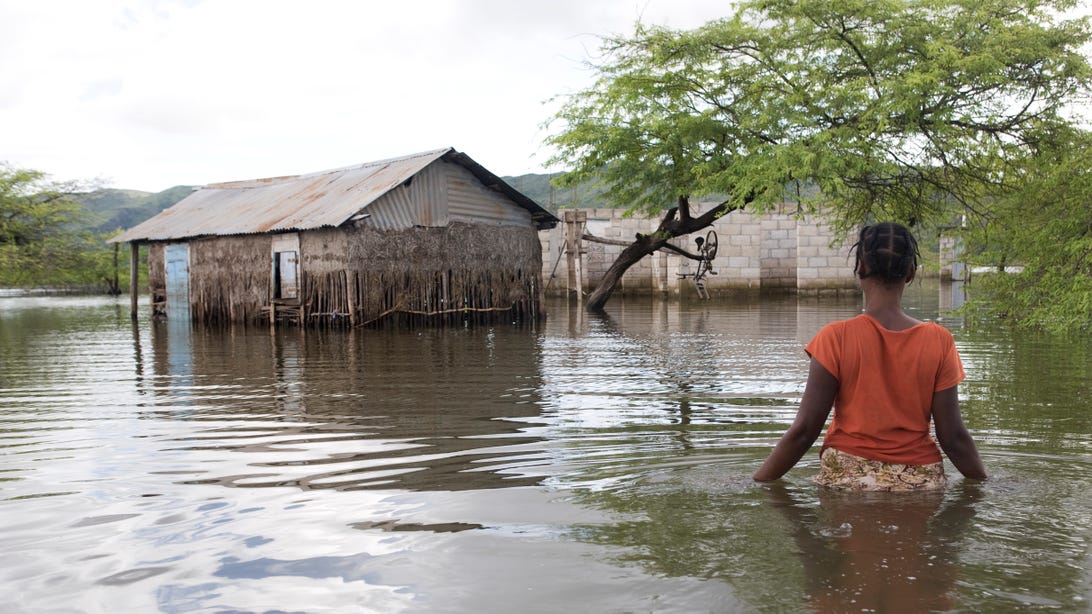
More extreme weather events, like hurricanes and floods, will happen as global temperatures continue to rise.
Gideon Mendel/GettyIf nations stick to the climate pledges made ahead of last year’s climate change conference COP26 and reduce greenhouse gas emissions, the Earth can limit warming to just below 2 degrees Celsius by 2100, according to new modelling released Wednesday in the journal Nature.
Malte Meinhausen, a climate scientist at the University of Melbourne and first author of the new paper, said the study is a good news story — but also isn’t.
Temperatures have already risen by 1.1 degrees Celsius over pre-industrial levels but the good news is we can stay below the “symbolic” 2 degree mark with the current pledges, Meinhausen said. However, the study also shows we’ve almost certainly missed our chance to limit warming to 1.5 degrees Celsius, an ambitious mark urged in the Paris Agreement signed in 2015.
“It’s not a good news story,” Meinhausen said, “because our study clearly shows that increased action this decade is necessary for us to have a chance of not shooting past 1.5 degrees by a wide margin.”
The study, published Wednedsay and featuring climate experts from the University of Melbourne, the International Energy Agency and Potsdam Institute for Climate Impact Research, examined climate pledges and greenhouse gas emissions targets submitted by 196 countries from 2015 until the end of the COP26 meeting, which took place in Glasgow in November.
Leading up to COP26, nations updated their emissions reductions targets for 2030 (known as nationally determined contributions or “NDCs”) as required by the Paris Agreement. The new study makes the point that, by looking only at these commitments to 2030, temperature could peak between 1.6 and 4.4 degrees by 2100. This is in a similar range to some of the predictions made by climate organizations in November 2021 before COP26 was complete.
The team also projected further ahead using long-term net-zero targets set by many countries, including China, the US, India and others. The authors write that if the long-term targets are “implemented “in full and on time,” then warming could be limited to a median rise of 1.9 or 2 degrees Celsius by 2100.
“[O]verall, this is good news if you believe countries will implement their promises in full and on time,” said Andy Pitman, director of the ARC Centre of Excellence for Climate Extremes in Australia. “But note the uncertainty.”
The authors of the study point out there are uncertainties built into the modelling.
“The key one is the climate response to emissions of CO2,” said Zebedee Nicholls, a climate scientist at the University of Melbourne and co-author on the paper. How the climate will respond as more carbon dioxide is pumped into the atmosphere through fossil fuel use is particularly hard to definitively say — more CO2 means more heat, but how this disturbs geophysical processes is less certain. The headline median rise is “just below” 2 degrees but the team give a range of possible predictions, from 1.4 to 2.8 degrees of warming.
The next eight years, to 2030, are critical. But we’re still going in the wrong direction. The study suggests carbon dioxide emissions will rise 6% to 13% higher than 2010 levels by 2030. This is particularly worrying as the IPCC has stated carbon dioxide emissions need to have fallen by 45% by 2030, compared to 2010 levels, to keep below 1.5 degrees of warming.
Failing Paris
In the context of the Paris Agreement, the results are discouraging but not hopeless. They provide yet another damning indictment on the pledges made by the 193 nations party to the Paris Agreement. The agreement states those parties should attempt to keep “well below” 2 degrees of warming. It also states nations should pursue efforts to limit warming to 1.5 degrees. Unfortunately, the new analysis shows that even meeting the net-zero pledges would only give us a 1-in-10 chance of staying below the 1.5 mark. Pitman noted that it’s “basically wishful thinking and/or gambling with the planet’s future.”
In short, we’re going to fail to meet the chief goal of the Paris Agreement in regards to limiting warming by 2100.
Recent IPCC reports on the science and impacts of climate change show that warming of more than 1.5 degrees could be catastrophic. It would increase the likelihood of extreme weather events, threaten Pacific Island nations and jeopardize food security. And given increasing impacts of climate change are already being felt at 1.1 degrees of warming, there’s a lot more work to do.
“The pledges that have been made need to be substantially enhanced,” said Christophe McGlade, head of the energy supply unit at the International Energy Agency. “What we need to see is that countries without net zero targets, announce and implement such targets.”
There is some cause for optimism. At COP26, nations signed the Glasgow Climate Pact, which states signatories should begin to phase down coal usage. Importantly, it states more ambitious climate targets for 2030 should be made when nations reconvene at COP27, to be held in Cairo this November.
There’s reason to believe climate policies will continue to be refined and become more ambitious over time, too, as social movements place increasing political pressure on governments to cut greenhouse gas emissions. But the study builds on a wealth of data showing this decade is, definitively, the last chance to make deep cuts before we lock in catastrophic warming.

